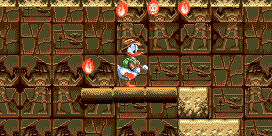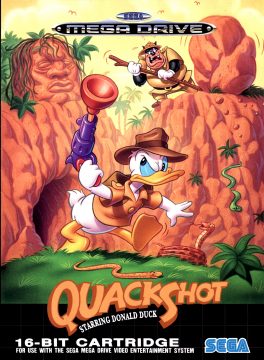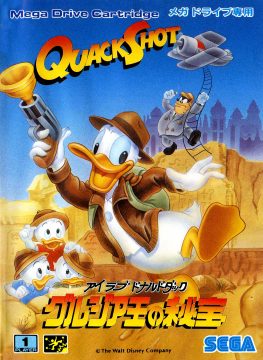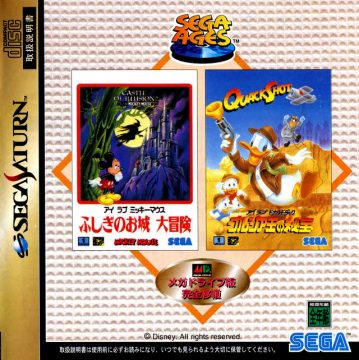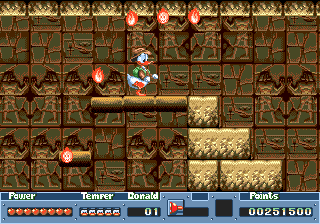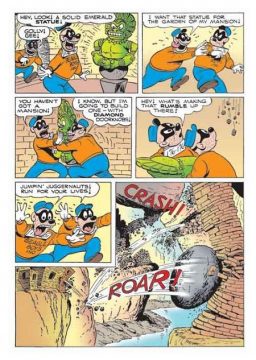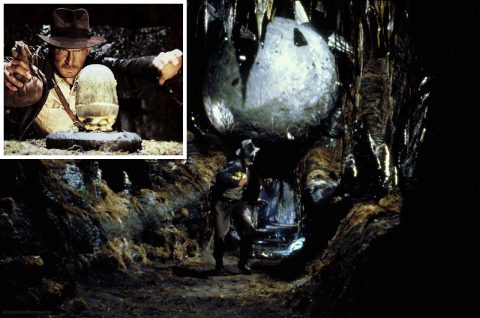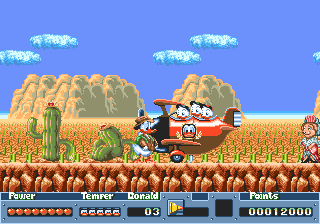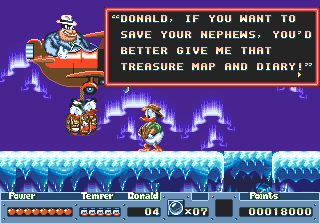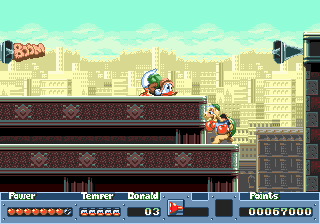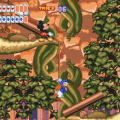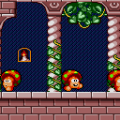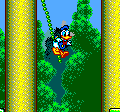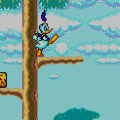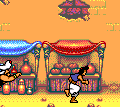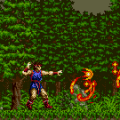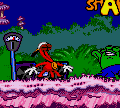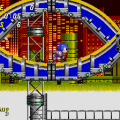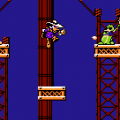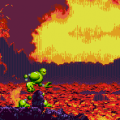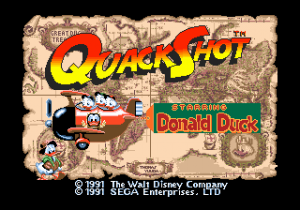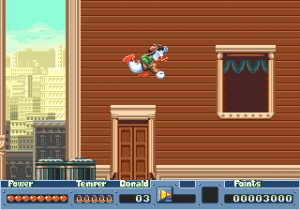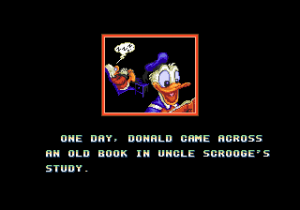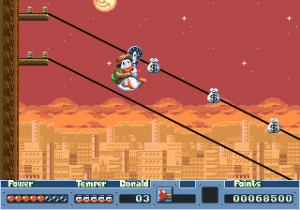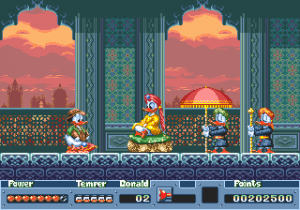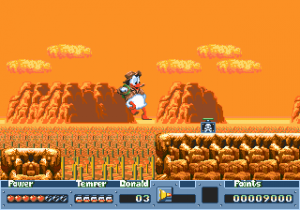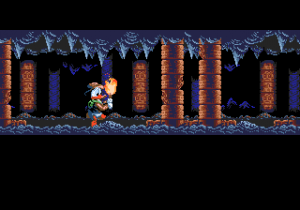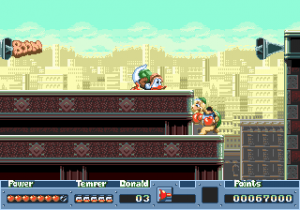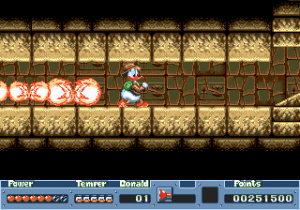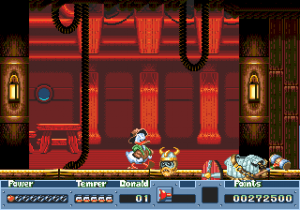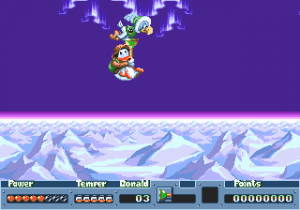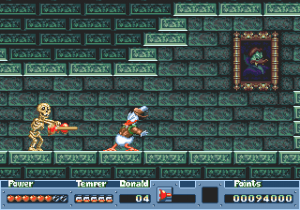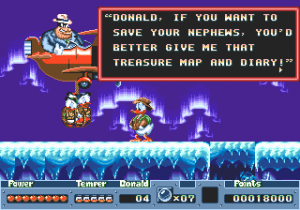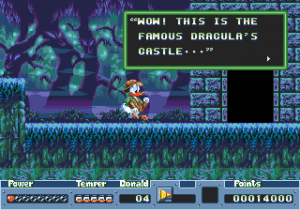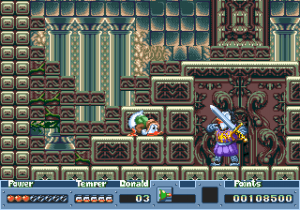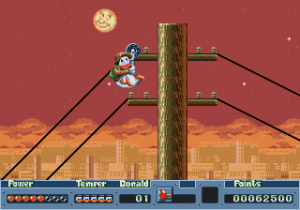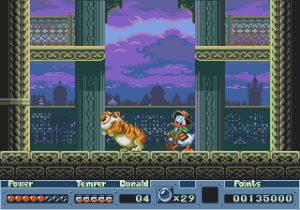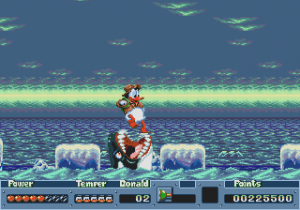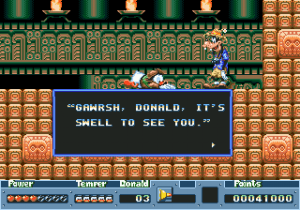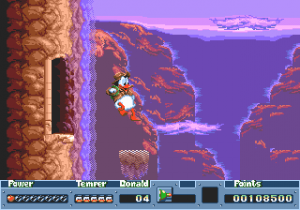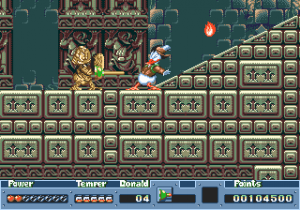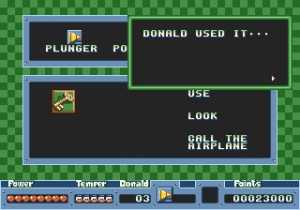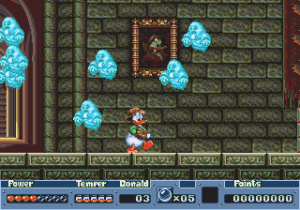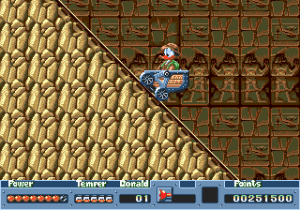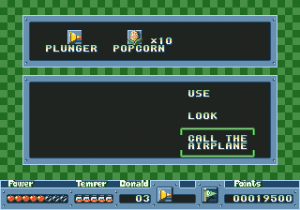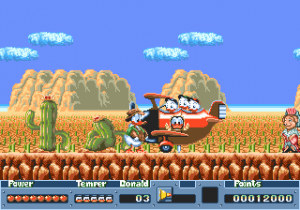When Sega of Japan initially got the Disney license in 1990, it became clear that the company had a much different take on how to utilize the well know characters in their video games. All the way up until 1990, Disney’s games had a reputation of being either overly kiddy and unengaging like Hudson/Capcom’s Mickey Mousecapade, or just simple education software for the very youngest to enjoy. Sega, on the other hand, had a different idea. Taking the best designers and programmers in-house, their Disney games would be built around the idea of creating a game using the property as their main influence and logically use the signatures and characters in their roles, instead of making a game first and shoehorning in the property as an afterthought. Castle Of Illusion was the first game to showcase this in late 1990, but no game in Sega’s Disney series demonstrates their attention to detail and quality as well as Quackshot starring Donald Duck.
Quackshot is often cited as an Indiana Jones-inspired adventure platformer. Indeed, Indiana Jones seems to have been one of the major influences on the game’s design, being set in a 1930s-style atmosphere, the logo being pretty much a direct copy of that which is used for Indy’s logo and of course, Donald himself wears a brown hat and leather jacket. But there is actually more to this style than simply being taken from Indiana Jones, and Sega really went to town with their research and homework to make this game work on a deeper level than what many actually realize at first glance.
Carl Barks was an artist who had worked at the Walt Disney Studios as an inbetweener in the animation department during the 1930s. During his time at Disney, he had also been responsible for half the artwork to Donald Duck’s first comic book adventure, Donald Duck Finds Pirate Gold. When the working environment changed significantly due to World War II, Barks actually quit Disney and relocated in hope of starting a poultry farm. In order to fund this, he turned to his hobby of drawing and story writing and pitched the idea of doing Donald Duck comic book shorts to the publisher of Pirate Gold, Western Publishing. He was immediately signed and would go on to make over 500 stories about the Disney ducks. Due to Disney’s policy of writers being anonymous, he was recognized as “The Good Duck Artist” until the discovery of his identity in 1959.
Under Barks’s pen, Donald became more of an accidental hero. In the cartoon shorts and other media, Donald had always been depicted as careless and sometimes downright antagonistic with his temper always getting the better of him. Under Barks’s pen however, Donald was suddenly given a much more balanced character who showcased more humanlike behavior, often being heroic and caring for his friends and family, though he did at times showcase a temper and didn’t always have the best intuition. Barks’s tales often took Donald to every corner of the world seeking out treasures and lost artifacts of history and was surrounded by many new characters and locations to further blossom the world of Donald. Just a few examples of Barks’s creations to the Disney universe would be Duckburg, Scrooge McDuck, the Beagle Boys and Magica De Spell. Stephen Spielberg and George Lucas have openly admitted that one of the inspirations for Indiana Jones was Barks’s Duck stories, which is evident at the beginning of Raiders of the Lost Ark where Indy triggers the rolling boulder the same way that the Beagle Boys had done in the Seven Cities of Cibola comic from 1954.
 Even though the most obvious and immediate inspiration seems to be Indiana Jones, there are a lot of similarities in the game to the works of Barks and his unique Donald universe. Sega delved deep into the archives and managed to piece together a game that not only felt great in terms of gameplay, but also as a Donald Duck product. All the Disney platformers were designed by a Japanese Sega designer who worked under the pseudonym Emirin.
Even though the most obvious and immediate inspiration seems to be Indiana Jones, there are a lot of similarities in the game to the works of Barks and his unique Donald universe. Sega delved deep into the archives and managed to piece together a game that not only felt great in terms of gameplay, but also as a Donald Duck product. All the Disney platformers were designed by a Japanese Sega designer who worked under the pseudonym Emirin.
The story starts when Donald goes through Uncle Scrooge’s books one day out of curiosity. Just by chance, he stumbles upon a treasure map that leads to the treasure of King Garuzia, the ancient ruler of the Duck Kingdom. Immediately filled with excitement over the fortune this map might lead to, Donald decides to set off on his adventure to find the ancient treasure but unfortunately for him, his discovery and plans are overheard by Big Bad Pete, who gets a head start on the quest ahead. The map Donald found is only partially complete however, so there is no other choice but to travel to the locations shown on the partial map first to figure out the true location. Many of the locations you visit are based on famous characters and places from Barks’s comic books, like Transylvania, where you fight Count Dracula; an old Viking ship (The Golden Helmet); Egypt (Donald Duck and the Mummy’s Ring); and the South Pole (A Cold Bargain, Frozen Gold). Donald also visits Duckburg and Mexico, which resembles the 1930s time period and settings found in the Indiana Jones franchise.
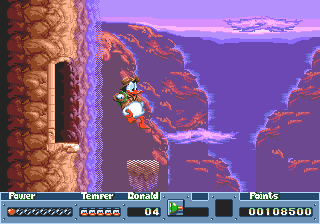 Donald’s quest is determined by a semi linear structure. You are free to travel to any of the location found on the map and explore the level, but often, a special item or upgrade is needed in order to fully complete the level. Donald then sets up a checkpoint flag which allows him to call his plane in the options menu, and also return to the same location when he returns with the required attribute. In order to make it easier to figure out where to go, several characters appear at the checkpoint to give him advice and hints on where to go next. These characters are mostly familiar faces such as Goofy and Daisy Duck in exotic costumes.
Donald’s quest is determined by a semi linear structure. You are free to travel to any of the location found on the map and explore the level, but often, a special item or upgrade is needed in order to fully complete the level. Donald then sets up a checkpoint flag which allows him to call his plane in the options menu, and also return to the same location when he returns with the required attribute. In order to make it easier to figure out where to go, several characters appear at the checkpoint to give him advice and hints on where to go next. These characters are mostly familiar faces such as Goofy and Daisy Duck in exotic costumes.
The main form of attack is Donald’s plunger gun. This gun can be aimed either straight up or at enemies straight ahead. The plunger gets upgraded throughout the game as well. In the beginning the plungers are yellow and is only used to temporarily stun enemies so the heroic duck can casually stroll past without taking damage. Later on, they turn red which allows them to stick onto walls and springboard Donald higher up with a well timed jump. Last, they turn green and can now stick to passing birds so Donald can hold on and cross over great gaps and distances, even though he technically should be able to fly being a duck and all. The plunger gun can also shoot popcorn, which is a three way canon that takes enemies out completely and bubble gum, which can also take out boulders and obstructing blocks. These come in limited quantity however. If Donald collects five chili peppers, he goes into a temper tantrum and runs full speed, taking out everything in his way for a few seconds.
All the levels are packed with enemies and layouts that keep the action going at all times. The most common enemies are Pete’s henchmen who will shoot you from a distance, but there are also bomb dropping birds, boxing turtles and Nordic ghosts. There are even some cameos in the enemy roster, as Shere Khan and Kaa The Snake appear at various stages in the game. Though not every level has a boss, most stages contains some form of residing villain for Donald to face before getting the artifact he is in search for. These artifacts are used by going into the start menu and using them at the appropriate location. There is also a “Look” command which often supplies hints and other tidbits with helps Donald figuring out where it belongs.
The levels remain varied and different for each area of the world, with the cityscape providing some rooftop platforming and zip-lining over the telephone lines while the South Pole causes Donald to slide while jumping on the floating ice blocks. There are mines and pyramids with lots of booby traps and even a mine cart section, again referencing Indiana Jones. There are also numerous secret rooms on many of the different sections of the game with lots of energy refills and gum ammo. There’s even a bit of puzzle solving to be done, making Donald a worthy archaeologist and adventurer.
Sega took everything that made both Castle of Illusion and Lucky Dime Caper and pull out all the stops with Quackshot. It is a brilliant game on near all aspects. Graphically the game is one of the best looking games on the Genesis, with fantastic color use with Duckburg especially having a somewhat beige industrial feeling, smooth animations, recognizable characters and unique landscapes for each level. The backgrounds are rich and alive, adding a lot of depths and atmosphere at every step along the way. Even though the game was released in 1991, it remains one of the very best looking titles ever put out by Sega on their 16-bit platform.
This is not only true for the graphics, but also the sound and music as well. The Genesis can be quite the roller coaster in terms of its audio output, ranging from absolutely amazing to downright offensive. Quackshot features a glorious soundtrack with excellent audio design however, and the soundtrack is also some of the best you will hear on the Genesis, with ragtime fueling the 1930s setting of Duckburg while the rest of the game follows the tradition game music upbeat pop style found in many contemporary platformers. The music was composed by Kamiya Studio, who was also responsible for most of Sega of Japan’s Disney outings. On the graphical side of things, this was also one of the earlier titles Thomas Yuda was art director on. Yuda would later go on to design the character Knuckles from Sonic The Hedgehog and also produced several Sonic titles.
Unlike Castle of Illusion, Quackshot did not get a 8-bit conversion, rather Lucky Dime Caper acted as its counterpart and is designed by the same team. It did get two re-releases – one on the Genesis as part of a double pack and one on the Sega Saturn in 1998, though only in Japan as part of the Sega Ages series. Both these releases were along with Castle of Illusion. The Sega Saturn release is emulated and is identical to the Genesis version.
Quackshot came at a time when Sega were definitely in their golden age, and they were able to make gold out of almost everything they touched. Even a game based on Michael Jackson songs became a classic due to their brilliance. It’s a game that is found in most Genesis collections due to being so widespread, but for those who don’t have it, it’s one to keep on top of the “to get list”. It’s not only one of the best Disney games ever made, but one of the best platformers on the Genesis as a whole.
